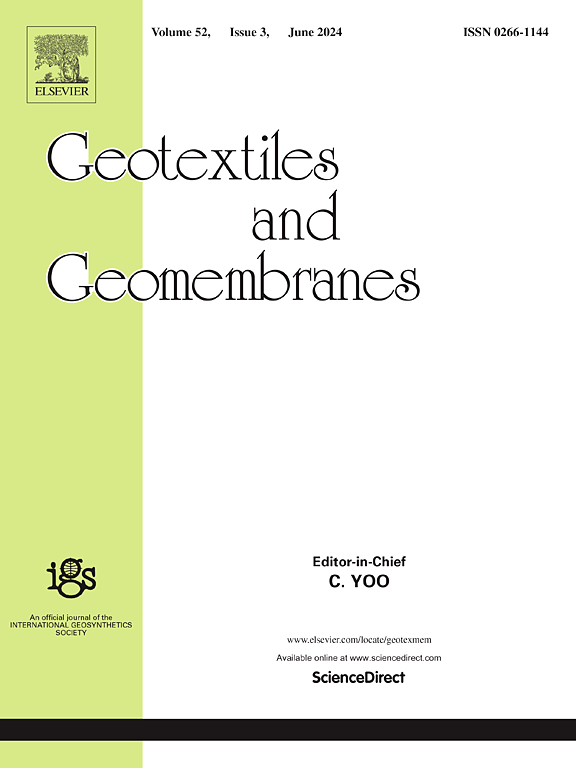Performance of unreinforced and geogrid-reinforced pile-supported embankments under localized surface loading: Analytical investigation
IF 4.7
1区 工程技术
Q1 ENGINEERING, GEOLOGICAL
引用次数: 0
Abstract
An analytical solution is proposed to identify the performance of unreinforced and geogrid-reinforcement pile-supported embankments under localized surface loading at working stress conditions based on the total efficacy and efficacy induced by soil arching alone, average strain of geogrid reinforcement, and average settlement of subsoil. This solution considered interactively soil arching within the embankment fill, the load-deflection behavior of geogrid reinforcement (if existed), and subsoil settlement. Specifically, the soil arching consisted of a structural arch with different stress states (evaluated by the elastoplastic state coefficient K) and a frictional arch. The load-deflection behavior of geogrid reinforcement was modeled by a membrane, with due consideration of the skin friction between the geogrid and soil. The subsoil was idealized as a one-dimensional compression model. The effectiveness of the proposed solution was verified by comparisons with results from the collected literature. It is shown that geogrid reinforcement improved the performance of embankments with low subsoil stiffness significantly more than that of those with high stiffness subsoil. A high tensile stiffness geogrid was found to be inefficient because its contribution to reducing the subsoil settlement and enhancing the load transfer efficacy was minimal. This paper provides a significant reference for optimizing these embankment design.
局部地表荷载下无加固和土工格栅加固桩支撑路堤的性能:分析研究
本文提出了一种分析解决方案,以确定无加固和土工格栅加固桩支撑路堤在工作应力条件下承受局部地表荷载时的性能,其依据是土拱引起的总功效和单独功效、土工格栅加固的平均应变以及基土的平均沉降。该方案综合考虑了路堤填土中的土拱效应、土工格栅加固(如存在)的荷载-挠度行为以及底土沉降。具体来说,土拱包括具有不同应力状态(通过弹塑性状态系数 K 评估)的结构拱和摩擦拱。土工格栅加固的荷载-挠度行为是通过膜来模拟的,并适当考虑了土工格栅与土壤之间的表皮摩擦。底土被理想化为一维压缩模型。通过与收集到的文献结果进行比较,验证了所提解决方案的有效性。结果表明,土工格栅加固对低基土刚度路堤性能的改善程度明显高于高基土刚度路堤。研究发现,高拉伸刚度土工格栅的效率很低,因为它对减少基土沉降和提高荷载传递效率的作用微乎其微。本文为优化这些路堤设计提供了重要参考。
本文章由计算机程序翻译,如有差异,请以英文原文为准。
求助全文
约1分钟内获得全文
求助全文
来源期刊

Geotextiles and Geomembranes
地学-地球科学综合
CiteScore
9.50
自引率
21.20%
发文量
111
审稿时长
59 days
期刊介绍:
The range of products and their applications has expanded rapidly over the last decade with geotextiles and geomembranes being specified world wide. This rapid growth is paralleled by a virtual explosion of technology. Current reference books and even manufacturers' sponsored publications tend to date very quickly and the need for a vehicle to bring together and discuss the growing body of technology now available has become evident.
Geotextiles and Geomembranes fills this need and provides a forum for the dissemination of information amongst research workers, designers, users and manufacturers. By providing a growing fund of information the journal increases general awareness, prompts further research and assists in the establishment of international codes and regulations.
 求助内容:
求助内容: 应助结果提醒方式:
应助结果提醒方式:


